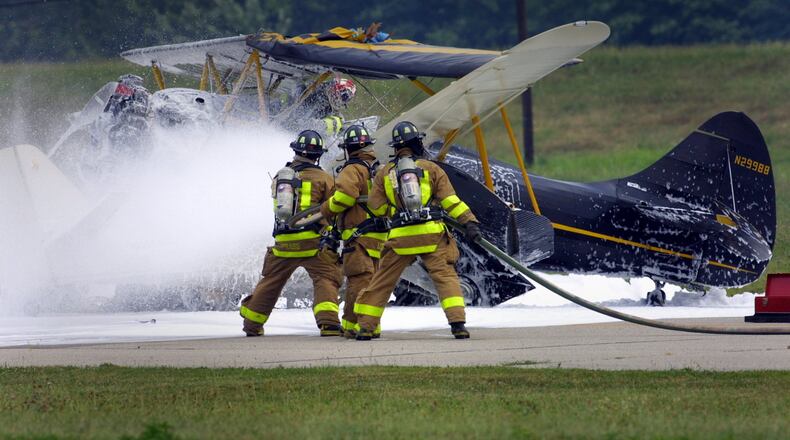Of that amount, the Air Force has spent nearly $59 million to address the chemicals at Wright Patterson, said a spokesman for the Air Force Installation and Mission Support Center.
Wright-Patterson is one of 191 installations where the release of PFAS has been confirmed, the spokesman said.
Through the Environmental Protection Agency Comprehensive Environmental Response, Compensation, and Liability Act (also known as the “Superfund” process), 26 AFFF — aqueous film-forming foam — release sites have been investigated at Wright-Patterson, said Mark Kinkade, the Air Force Installation and Mission Support Center spokesman.
The next phase is remedial investigation to fully delineate the presence of PFAS in soil, groundwater, and surface water, he said.
Work at Wright-Patterson has included five new technology studies in water treatment, PFAS destruction, and modeling, he said, including the “first-ever gravity upflow basin system.”
To remove PFAS from surface water and groundwater, an engineered clay media is being used in the system. This approach marks “a significant advancement in this field,” Kinkade said.
“Leaning forward”
“The key here is that we have a plan, and we will implement it,” Jenni Dorsey-Spitz, an environmental technical advisor to the Deputy Assistant Secretary of the Air Force for Installations, Energy, and Environment, said in a recent Air Force statement addressing work at all affected Air Force installations.
“We aren’t starting from scratch,” she said. “The Department of the Air Force, without a regulatory standard, leaned forward to start addressing PFAS and we will continue leaning forward with the new standard.”
PFAS are synthetic chemicals found in the air, water, and soil and can take centuries to break down in the environment.
At Wright-Patterson, the Air Force installed granular activated carbon treatment systems on two on-base wells where PFAS was present above screening levels.
“We are also implementing removal actions to treat impacted groundwater and surface water at five on-base locations where aqueous film-forming foam containing PFAS was released, to mitigate migration to the city of Dayton water supply wells,” Kinkade said in response to questions from the Dayton Daily News. The city has sued WPAFB over PFAS contamination.
As part of the remedial investigation, over 170 monitoring wells have been installed on the base and over 480 soil samples, 313 groundwater samples, 87 sediment samples, 67 surface/stormwater samples and 48 lysimeter samples have been collected, Kinkade said.
New EPA standards
In April, the Environmental Protection Agency (EPA) issued a strict national regulation limiting the amount of PFAS found in drinking water.
The EPA said it will require that public water utilities test for six types of PFAS chemicals to reduce exposure in drinking water.
Those include two of the common PFAS chemicals found in AFFF, a foam once used by the military and civilian aviation to control petroleum fires, the Air Force said.
In May, Dorsey-Spitz, the environmental technical advisor, said the newly established EPA levels will help the Air Force detect and treat PFAS.
“The MCL (maximum contaminant levels) provides clear guidance on what the regulatory community considers a reasonable standard for assessing risk to human health,” she said.
Since 2015, the Air Force has inspected sites at 204 installations to determine whether AFFF may have been used or released into the environment.
Of those, 191 installations had confirmed releases of PFAS, including Wright-Patterson.
Credit: Paregien
Credit: Paregien
City of Dayton lawsuit
The city of Dayton in 2021 filed a $300 million lawsuit against Wright-Patterson and the U.S. Department of Defense.
The Dayton Daily News reported in March last year that the case was transferred to a federal court in South Carolina in 2021 under a statute called “multi-district litigation.” It was consolidated with some 10,000 other PFAS-related lawsuits, where little action has taken place.
To address PFAS contamination where it’s found, the Air Force says it has, among other measures, provided alternate drinking water to impacted private well owners, funded water purveyors to install filtration systems, and took interim response actions such as installing pump-and-treat systems to prevent further migration of PFAS in groundwater.
The new EPA standards could mean more sampling of off-base drinking water supplies, Dorsey-Spitz said.
About the Author



